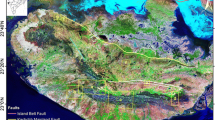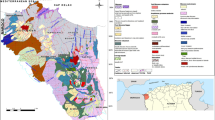Abstract
Remote sensing was used to visualize the West region with the purpose of investigating recent natural hazards observed in this area. Various approaches used based on multi-spectral information such as PCA, band compositions, NDVI, and texture analysis are used to investigate landslide and new faults in the region of West Cameroon. The combination of remote sensing techniques with fieldwork and photogrammetry has been probed again and helped to detect three (03) new faults and to characterise the recently assumed landslide as a rock fall characterised by an accumulation of fresh rock deposits downwards, from the edge to the valley. In this study, we extracted in this region all linear and curvilinear edges resulted from geomorphological features, geological structures, rock composition, vegetal tonal contrasts, soil moisture, and human activities. These features are terraces, linear valleys and cliffs, faults, joints, and other line weaknesses, tracks, buildings, roads and rivers. They are overlain on rivers, highways and digital elevation model maps for preliminary validation. Then, a post-processing fieldwork has been conducted to avoid any confusion with faults. The digital elevation model and the derived slope maps enabled fracturing to be discerned. Existing known faults have also been identified in this study.










Similar content being viewed by others
References
Abdelsalam MG, Liégeois JP, Stern RJ (2002) The Saharan metacraton. J Afr Earth Sci 34:119–136. https://doi.org/10.1016/S0899-5362(02)00013-1
Akbar TA, Ha SR (2011) Landslide hazard zoning along Himalayan Kaghan Valley of Pakistan—by integration of GPS, GIS, and remote sensing technology. Landslides 8:527–540. https://doi.org/10.1007/s10346-011-0260-1
Aretouyap Z, Billa L, Jones M, Richter G (2020) Geospatial and statistical interpretation of lineaments: salinity intrusion in the Kribi-Campo coastland of Cameroon. Adv Space Res 66:844–853. https://doi.org/10.1016/j.asr.2020.05.002
Bang H, Miles L, Gordon R (2019) Evaluating local vulnerability and organisational resilience to frequent flooding in Africa: The case of Northern Cameroon. Foresight 21(2): 266–284. http://eprints.bournemouth.ac.uk/31569/.
Bhavnani R, Vordzorgbe S, Owor M, Bousquet F (2008) Report on the Status of Disaster Risk Reduction in the Sub-Saharan Africa Region. Commission of the African Union, United Nations and the World Bank. Available from: http://www.unisdr.org/files/2229DRRinSubSaharanAfricaRegion.pdf〉(accessed 23.02.2020).
Chang RT, Liu JK (2004) Landslide features interpreted by neural network method using high-resolution satellite image and digital topographic data. Proc. ISPRS04, Istambul, Turkey
Dong J, Lai P, Chang C, Yang S, Yeh K, Liao J, Pan Y (2014) Deriving landslide dam geometry from remote sensing images for the rapid assessment of critical parameters related to dam-breach hazards. Landslides 11:93–105. https://doi.org/10.1007/s10346-012-0375-z
Fernández T, Jiménez J, Fernández P, El Hamdouni R, Cardenal FJ, Delgado J, Irigaray C, Chacón J (2008) Automatic detection of landslide features with remote sensing techniques in the Betic Cordilleras (Granada, Southern Spain). The International archives of the photogrammetry, remote sensing and spatial information sciences. Vol. XXXVII. Part B8. Beijing 2008:351–356
Fraser JRS (2016) The role of the board in risk management oversight. In: Leblanc Richard (ed) the handbook of board governance. Wiley, Hoboken NJ, pp 285–304
Ghomsi FEK, Sévérin N, Mandal A, Nyam FEA, Tenzer R, Kamga APT, Nouayou R (2020) Cameroon’s crustal configuration from global gravity and topographic models and seismic data. J Afr Earth Sci 161:103657. https://doi.org/10.1016/j.jafrearsci.2019.103657
Hung LQ, Batelaan O, De Smedt F (2005) Lineament extraction and analysis, comparison of Landsat ETM and ASTER imagery. Case study: Suoimuoi tropical karst catchment. Vietnam. Remote Sens Environ Monit GIS Appl Geol V 5983:1–512. https://doi.org/10.1117/12.627699
Igwe O (2015) The study of the factors controlling rainfall-induced landslides at a failure-prone catchment area in Enugu, Southeastern Nigeria using remote sensing data. Landslides 12:1023–1033. https://doi.org/10.1007/s10346-015-0627-9
Ji S, Yu D, Shen C, Li W, Xu Q (2020) Landslide detection from an open satellite imagery and digital elevation model dataset using attention boosted convolutional neural networks. Landslides. https://doi.org/10.1007/s10346-020-01353-2
Kwékam M, Liégeois JP, Njonfang E, Affaton P, Hartmann G, Tchoua F (2010) Nature, origin and significance of the Fomopéa Pan-African high-K calc-alkaline plutonic complex in the Central African fold belt (Cameroon). J Afr Earth Sci 57:79–95. https://doi.org/10.1016/j.jafrearsci.2009.07.012
Lerouge C, Cocherie A, Toteu SF, Penaye J, Milési JP, Tchameni R, Nsifa EN, Fanning CM, Deloule E (2006) Shrimp U-Pb zircon age evidence for Paleoproterozoic sedimentation and 2.05 Ga syntectonic plutonism in the Nyong group, South-Western Cameroon: consequences for the Eburnean-Transamazonian belt of Ne Brazil and Central Africa. J Afr Earth Sci 44:413–427. https://doi.org/10.1016/j.jafrearsci.2005.11.010
Liao Z, Hong Y, Wang J, Fukuoka H, Sassa K, Karnawati D, Fathani F (2010) Prototyping an experimental early warning system for rainfall-induced landslides in Indonesia using satellite remote sensing and geospatial datasets. Landslides 7:317–324. https://doi.org/10.1007/s10346-010-0219-7
Marzoli A, Piccirillo EM, Renne PR, Bellieni G, Iacumin M, Nyobe JB, Tongwa AT (2000) The Cameroon volcanic line revisited: petrogenesis of continental basaltic magmas from lithospheric and asthenospheric mantle sources. J Petrol 41:87–109. https://doi.org/10.1093/petrology/41.1.87
Mazas F (2019) Extreme events: a framework for assessing natural hazards. Nat Haz 98:823–848. https://doi.org/10.1007/s11069-019-03581-9
Ngako V (1999) Les déformations continentales panafricaines en Afrique centrale, résultat d’un poinçonnement de type himalayen. Thèse Doctorat Etat, Université Yaoundé I, p 301
Ngako V, Affaton P, Nnange JM, Njanko T (2003) Pan-African tectonic evolution in central and southern Cameroon: transpression and transtension during sinistral shear movements. J Afr Earth Sc 36:207–214
Ngako V, Affaton P, Njonfang E (2008) Pan-African tectonics in northwestern Cameroon: implication for the history of western Gondwana. Gondwana Res 14:509–522. https://doi.org/10.1016/j.gr.2008.02.002
Nichol J, Shaker A, Wong MS (2006) Application of high-resolution stereo satellite images to detailed landslide hazard assessment. Geomorphology 76:68–75. https://doi.org/10.1016/j.geomorph.2005.10.001
Njonfang E, Ngako V, Moreau C, Affaton P, Diot H (2008) Restraining bends in high temperature shear zones: The “Central Cameroon Shear Zone”, Central Africa. J Afr Earth Sci 52:9–20. https://doi.org/10.1016/j.jafrearsci.2008.03.002
Ntieche B, Mohan MR, Moundi A (2017) Granitoids of the Magba shear zone, West Cameroon, Central Africa: Evidences for emplacement under transpressive tectonic regime. J Geolog Soc India 89:33–46. https://doi.org/10.1007/s12594-017-0556-4
Nzolang C, Kagami H, Nzenti JP, Holtz F (2003) Geochemistry and preliminary Sr–Nd isotopic data on the Neoproterozoic granitoids from the Bantoum area, West Cameroon: evidence for a derivation from a Paleoproterozoic to Archean crust. Polar Geoscience 16:196–226
Ouyang C, Zhao W, An H, Zhou S, Wang D, Xu Q, Li W, Peng D (2019) Early identification and dynamic processes of ridge-top rockslides: implications from the Su Village landslide in Suichang County, Zhejiang Province, China. Landslides 16:799–813. https://doi.org/10.1007/s10346-018-01128-w
Pepogo Man-mvele AD, Ndougsa-Mbarga T, Meying A, Ngoh JD, Mvondo-Ondoua J, Ngoumou PC (2018) New geological and structural facts under the lateritic cover in Garga Sarali, Ndokayo (East Cameroon) area, from audiomagnetotellurics soundings. Int J Geophy. https://doi.org/10.1155/2018/4806357
Plomerová J, Babuška V, Dorbath C, Dorbath L, Lillie RJ (1993) Deep lithospheric structure across the central african shear zone in Cameroon. Geophy J Int 115:381–390. https://doi.org/10.1111/j.1365-246X.1993.tb01193.x
Scaioni M, Longoni L, Melillo V, Papini M (2014) Remote sensing for landslide investigations: an overview of recent achievements and perspectives. Remote Sens 6:9600–9652. https://doi.org/10.3390/rs6109600
Toteu SF, Penaye J, Djomani YP (2004) Geodynamic evolution of the Pan-African belt in Central Africa with special reference to Cameroon. Canada J Earth Sci 41:73–85. https://doi.org/10.1139/e03-079
Toteu SF, Penaye J, Deloule E, Van Schmus WR, Tchameni R (2006) Diachronous evolution of volcano sedimentary basins north of the Congo craton: insights from U-Pb ion microprobe dating of zircons from the Poli, Lom and Yaoundé Groups (Cameroon). J Afr Earth Sci 44:428–442. https://doi.org/10.1016/j.jafrearsci.2005.11.011
UNDRR (2013) Tackling future risks, economic losses and exposure: developing the elements of the post-2015 framework for DRR. UNDRR, Geneva
Whitworth MCZ, Giles DP, Murphy W (2005) Airborne remote sensing for landslide hazard assessment: a case study on the Jurassic escarpment slopes of Worcestershire, United Kingdom. Quartery J Eng Geol Hydrogeol 38:285–300. https://doi.org/10.1144/1470-9236/04-057
Yang W, Wang Y, Wang Y, Ma C, Ma Y (2020) Retrospective deformation of the Baige landslide using optical remote sensing images. Landslides 17:659–668. https://doi.org/10.1007/s10346-019-01311-7
Youssef AM, Maerz NH, Hassan AM (2009) Remote sensing applications to geological problems in Egypt: case study, slope instability investigation, Sharm El-Sheikh/Ras-Nasrani Area. Southern Sinai. Landslides 6:353. https://doi.org/10.1007/s10346-009-0158-3
Acknowledgment
The first author is very thankful to the University of Nottingham the lab, software, hardware and equipment were used for remote sensing processing and GIS analysis.
Author information
Authors and Affiliations
Corresponding author
Additional information
Publisher's Note
Springer Nature remains neutral with regard to jurisdictional claims in published maps and institutional affiliations.
Supplementary Information
Below is the link to the electronic supplementary material.
Supplementary file1 (MP4 14723 KB)
Rights and permissions
About this article
Cite this article
Aretouyap, Z., Kemgang, F.E.G., Domra, J.K. et al. Understanding the occurrences of fault and landslide in the region of West-Cameroon using remote sensing and GIS techniques. Nat Hazards 109, 1589–1602 (2021). https://doi.org/10.1007/s11069-021-04890-8
Received:
Accepted:
Published:
Issue Date:
DOI: https://doi.org/10.1007/s11069-021-04890-8




